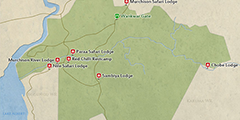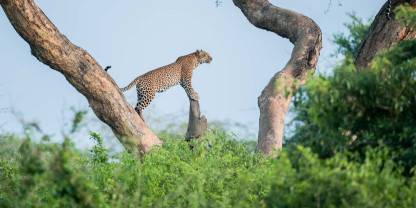Murchison Falls National Park is named for a spectacular waterfall on the Victoria Nile river as it explodes over the above Lake Albert. It is Uganda’s largest national park and home to plenty of wildlife including lions, elephants and buffalo. Boat trips to the base of the falls, along an atmospheric stretch of the Nile alive with hippos, crocodiles and birds, are a highlight.

-
Best Time To Go
- December to February (Easier to spot animals)
-
High Season
- June to September (Peak time for Uganda)
-
Size
- 3,840km² / 1,483mi²
-
Altitude
-
615-1,187m /2,018-3,894ft
 View Photos
View Photos
 View Photos
+24
Photos
View Photos
+24
Photos
 Open Map
Open Map
Pros & Cons
- Top wildlife viewing with four of the Big Five (no rhino)
- Home to East Africa’s most spectacular waterfall
- Boat trips along the Nile to Murchison Falls and the Lake Albert Delta
- One of the best places to look for the rare shoebill
- is possible at Budongo Forest on the park’s southern border
- A relatively long drive from the capital Kampala and Uganda’s other main parks
- Minor roads may become impassable during the Wet season
- Some areas have high seasonal densities of tsetse fly
Wildlife
Huge herds of elephant and buffalo are common, while lions and leopards are quite often seen in certain areas. The only absentee among the Big Five is rhino, which can be tracked en route at Ziwa Rhino and Wildlife Ranch if you are coming from Kampala. Murchison Falls NP is the world’s most important stronghold for Rothschild’s giraffe, which is often seen moving in large herds. Antelope include Jackson’s hartebeest, defassa waterbuck and Uganda kob. Chimpanzees can be tracked within the greater Murchison Falls Conservation Area at Budongo Forest.
More about Murchison’s wildlifeScenery
The park is bisected by the Victoria Nile. A boat trip along this atmospheric river brings you to the base of Murchison Falls, where the water squeezes through a narrow gorge before cascading down into the Devil’s Cauldron. Even more impressive is the view of this deafening cascade from the Top of the Falls. North of the river, a cover of rolling grassland is dotted with tall borassus palms. South of the river, the main habitat is dense woodland with forest patches.
Activities
The boat trip to the base of Murchison Falls is a must. By arrangement, you can hike from here to the viewpoint at the Top of the Falls, and have a car meet you there. Another worthwhile boat trip heads to the Lake Albert Delta to look for shoebills. The best circuit for runs north of the delta, but the quieter Honeymoon Track can be rewarding too. Activities often combined with a Murchison Falls safari include in Budongo Forest and rhino tracking at Ziwa Rhino and Wildlife Ranch.
Weather & Climate
Murchison Falls NP has a consistently hot climate. The minimal variation in average monthly temperatures is due to the park’s location close to the equator. It does, however, get slightly hotter during the Dry season (December to February). Light rain is usual in the Wet season (March to November), with the occasional storm blowing through. The wettest months are April to May and August to October.
More about the weather and climateBest Time To Visit
Wildlife spotting in Murchison Falls NP isn’t especially seasonal but it tends to be easiest in the Dry season (December to February). At this time, animals gather close to water and there’s less undergrowth for them to hide in. In June and July it’s also relatively dry, and usually a bit cooler during the middle of the day.
More about the best time to visit



